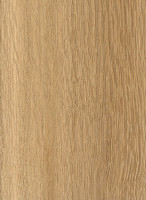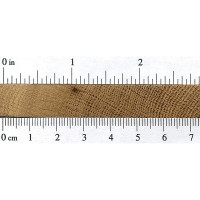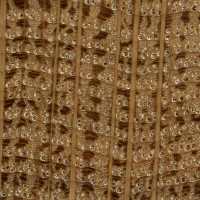 |
Common Name(s): Oregon White Oak
Scientific Name: Quercus garryana Distribution: Pacific Northwestern United States Tree Size: 65-85 ft (20-25 m) tall, 3-4 ft (1-1.2 m) trunk diameter Average Dried Weight: 51 lbs/ft3 (815 kg/m3) Specific Gravity (Basic, 12% MC): .64, .81 Janka Hardness: 1,640 lbf (7,310 N) Modulus of Rupture: 10,200 lbf/in2 (70.3 MPa) Elastic Modulus: 1,090,000 lbf/in2 (7.51 GPa) Crushing Strength: 7,320 lbf/in2 (50.5 MPa) Shrinkage: Radial: 4.2%, Tangential: 9.0%, Volumetric: 13.2%, T/R Ratio: 2.1 |
Color/Appearance: Has a light to medium brown color, though there can be a fair amount of variation in color. Conversely, Red Oak tends to be slightly redder, but is by no means a reliable method of determining the type of oak.
Grain/Texture: Has medium-to-large pores and a fairly coarse grain.
Rot Resistance: Good rot resistance: frequently used in boatbuilding applications.
Workability: Easy to glue, and takes stain and finishes very well.
Odor: Has a tell-tale smell that is common to most oaks. Most find it appealing.
Allergies/Toxicity: Although severe reactions are quite uncommon, oak has been reported as a sensitizer. Usually most common reactions simply include eye and skin irritation, as well as asthma-like symptoms. See the articles Wood Allergies and Toxicity and Wood Dust Safety for more information.
Pricing/Availability: Slightly more expensive than Red Oak, White Oak is in good/sustainable supply and is moderately priced. Thicker 8/4 planks, or quartersawn boards are slightly more expensive per board foot.
Sustainability: This wood species is not listed in the CITES Appendices or on the IUCN Red List of Threatened Species.
Common Uses: Cabinetry, furniture, interior trim, flooring, boatbuilding, barrels, and veneer.
Comments: White Oak, along with its brother Red Oak, are commonly used domestic lumber species. Hard, durable, and moderately priced, White Oak presents an exceptional value to woodworkers—which explains why it is so widely used in cabinet and furniture making.
- Black Oak (Quercus velutina)
- Bog Oak
- Brown Oak
- Bur Oak (Quercus macrocarpa)
- California Black Oak (Quercus kelloggii)
- Cherrybark Oak (Quercus pagoda)
- Chestnut Oak (Quercus prinus)
- English Oak (Quercus robur)
- Holm Oak (Quercus ilex)
- Japanese Oak (Quercus mongolica)
- Laurel Oak (Quercus laurifolia)
- Live Oak (Quercus virginiana)
- Overcup Oak (Quercus lyrata)
- Pin Oak (Quercus palustris)
- Post Oak (Quercus stellata)
- Red Oak (Quercus rubra)
- Scarlet Oak (Quercus coccinea)
- Sessile Oak (Quercus petraea)
- Shumard Oak (Quercus shumardii)
- Southern Red Oak (Quercus falcata)
- Swamp Chestnut Oak (Quercus michauxii)
- Swamp White Oak (Quercus bicolor)
- Turkey Oak (Quercus cerris)
- Water Oak (Quercus nigra)
- White Oak (Quercus alba)
- Willow Oak (Quercus phellos)
 |
 |
 |
 |





Does Oregon white oak have Madullary rays if it’s quarter sawn?
Yes
I just wanted to mention that Oregon white oak is also called Gary oak, particularly in Canada.
I have just started to learn wood working. I have been using pallets. I am making a hardwood floor. I am 330 sq feet into 550 sq feet. I am using all the hardwood I can find that is 3/4 inch thick after straightening on my jointer. Is there any wood I should be avoiding and please let me know why. Any info would be greatly appreciated.
I use the site nearly everyday to help me decide on how to use different woods. I would like to see more on how to identify reclaimed wood species.